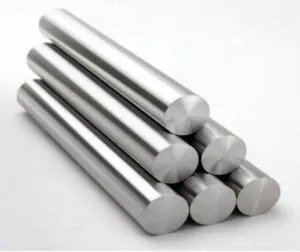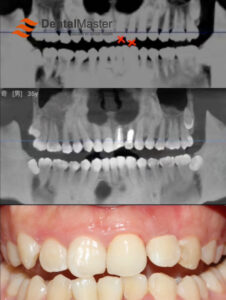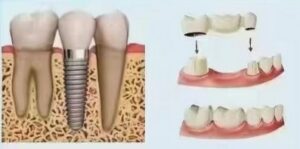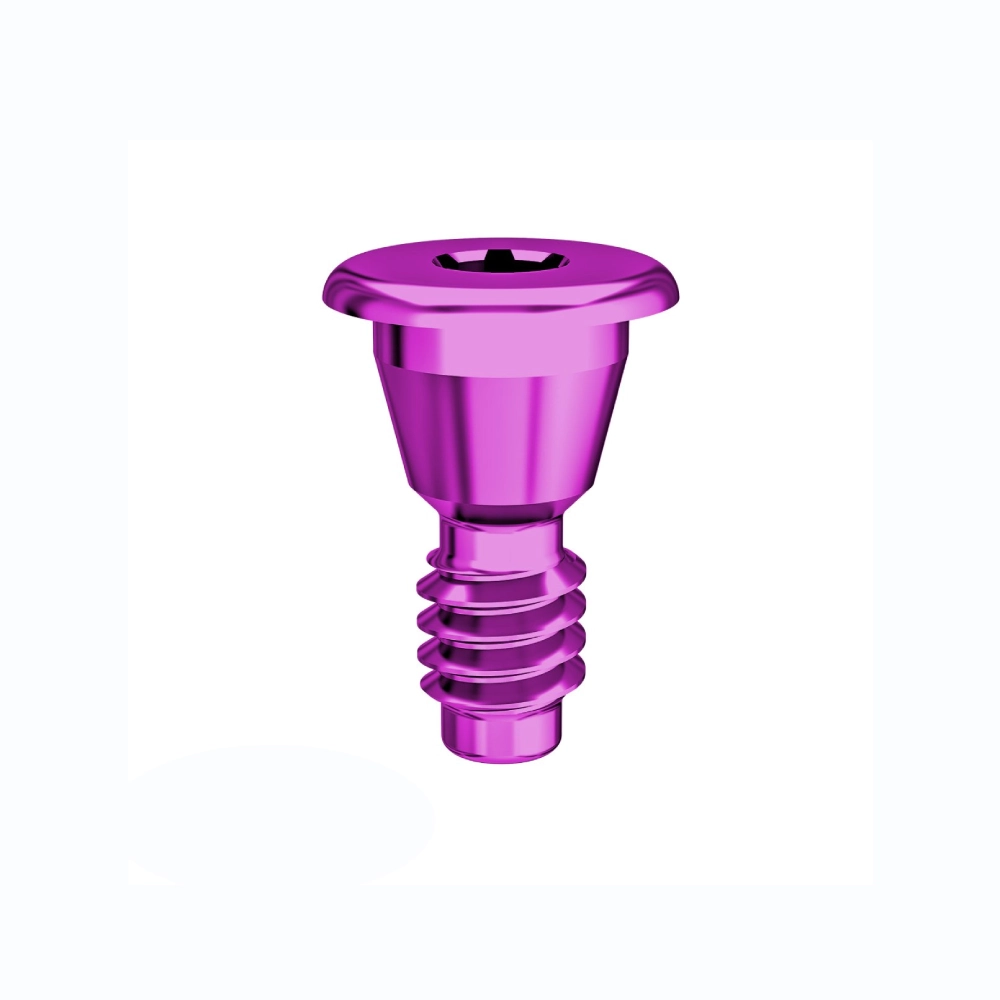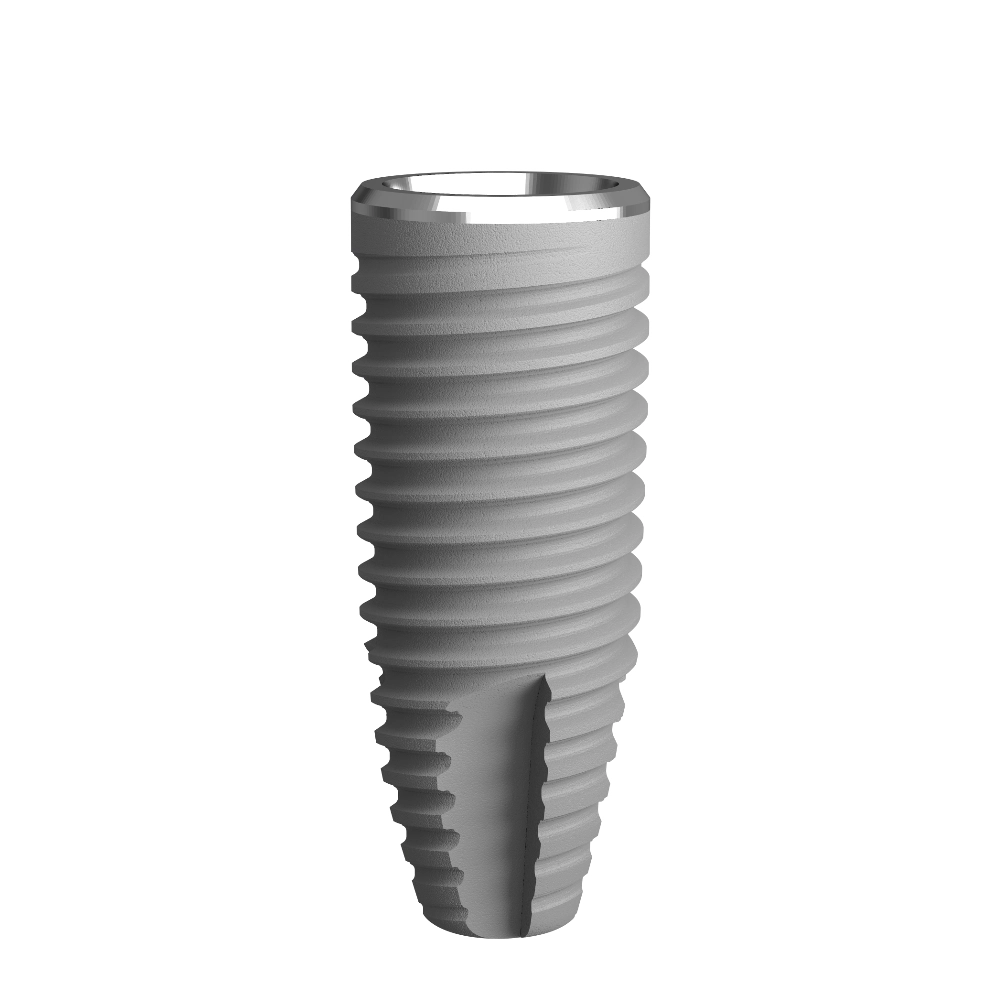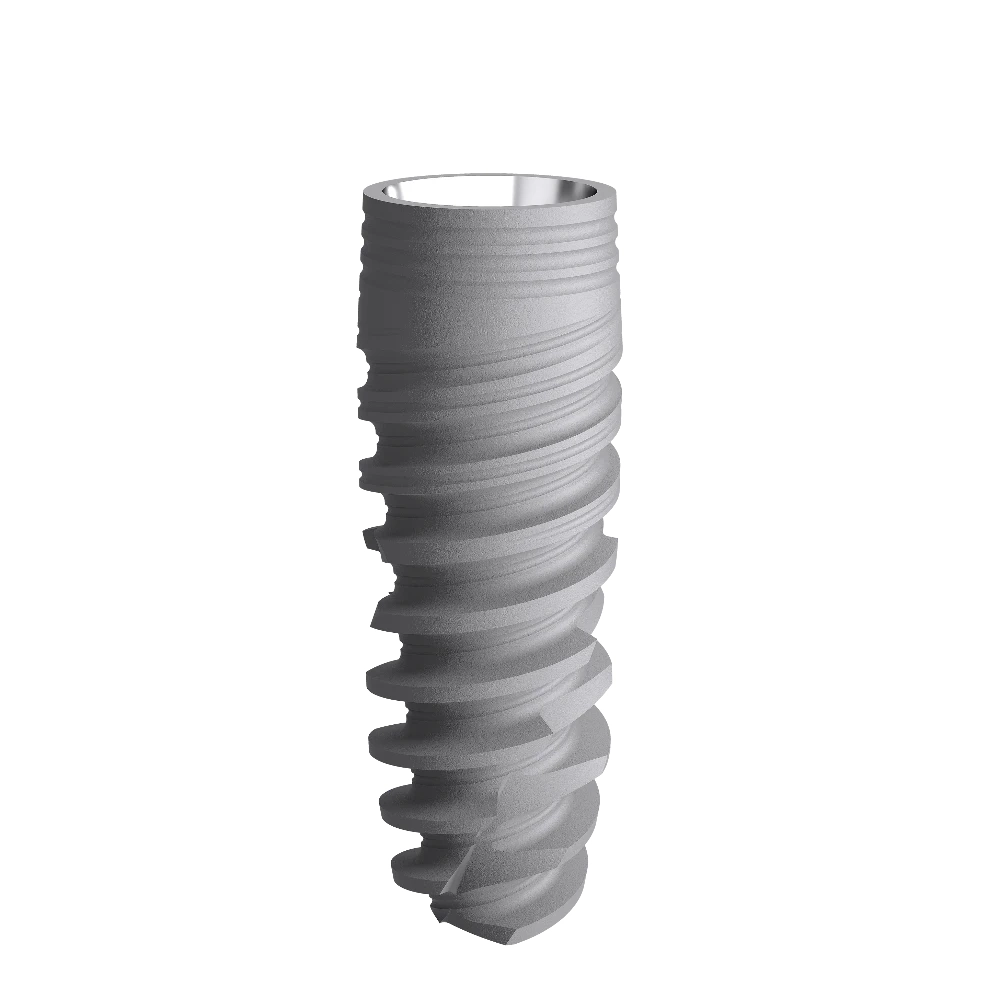In the field of dental restoration, the advent of dental implants represents a groundbreaking revolution.
It has brought new hope and superior treatment options to countless patients suffering from tooth loss. However, the clinical success of dental implants largely depends on whether a firm and lasting integration between the implant and the surrounding bone can be achieved — a crucial physiological process known as osseointegration.
The success of osseointegration is influenced by many factors, among which the surface characteristics of the implant play a pivotal role. Different surface treatment technologies endow implants with distinct microstructures and chemical properties, which in turn exert a profound impact on the speed, quality, and long-term stability of osseointegration.
Among the many complex surface treatment methods, SLA (Sandblasted, Large-grit, Acid-etched) surface treatment stands out due to its remarkable advantages and has become the gold standard in the industry. Through a specialized process, SLA technology creates a unique microtopography on the implant surface, providing an ideal microenvironment for bone cell adhesion, proliferation, and differentiation, thereby strongly promoting the osseointegration process.
This article will explore the principles of SLA technology in depth and present how デンタルマスター has further innovated and improved upon this well-established technique, aiming to achieve even more outstanding clinical outcomes and bring new vitality to the development of dental implant restoration.

SLA表面処理
In the field of dental implantation, the close integration between the implant and surrounding bone tissue—known as osseointegration—is the cornerstone of a successful procedure. SLA surface treatment, as a highly regarded implant surface modification technique, is playing a critical role in facilitating efficient osseointegration thanks to its unique advantages.
SLA surface treatment is essentially a precise and meticulously controlled two-step process.
The first step is sandblasting. In this stage, large-grit abrasive particles with a specific size are propelled at the implant surface under tightly regulated force and angle. The high-speed impact of these abrasive particles against the implant surface acts like a skilled sculptor, crafting a rough macrostructure. This macrostructure is not random, but instead exhibits a well-defined pattern and distribution, laying a solid foundation for subsequent biological responses.
Next comes the acid-etching process. After sandblasting, the implant is immersed in a strong acid solution for deep surface modification. The acid, like a magical craftsman, works on the already roughened macrostructure to etch countless micro-pits onto the surface. These microscopic depressions vary in size and shape, and when intertwined with the macrostructure, form a complex yet organized three-dimensional morphology.
This dual-modified surface architecture closely mimics the natural structure of human cancellous bone. As a vital component of the human skeletal system, cancellous bone offers an ideal microenvironment for cellular growth and tissue regeneration thanks to its unique microstructure. Similarly, SLA-treated implant surfaces exhibit these structural characteristics, creating highly favorable conditions for bone cell adhesion, proliferation, and differentiation.
From a biomechanical perspective, the increased surface area allows for more cellular attachment points and greater protein adsorption. Cells can adhere more tightly to the implant surface, and bone growth-promoting proteins are better able to exert their effects. These coordinated biological reactions significantly accelerate the osseointegration process, ultimately improving both the clinical success rate and long-term stability of dental implants.
Clinical Advantages of SLA Surfaces in Dental Implants
In the field of dental implantation, the choice of implant surface treatment technology directly impacts the success rate of surgery, the recovery experience of the patient, and the long-term stability of the implant. SLA (Sandblasted, Large-grit, Acid-etched) surface treatment technology, with its unique process and remarkable clinical advantages, has become the trusted choice of many dental professionals and patients.
Faster Initial Stability
During the early healing phase of dental implantation, whether the implant can quickly achieve strong initial stability is a key factor determining the progress of osseointegration. SLA-treated implant surfaces form a complex and unique microstructure through sandblasting and acid-etching processes, significantly increasing the mechanical interlocking between the implant and surrounding bone tissue. Once inserted into the alveolar bone, the rough surface of the implant closely fits the bone—much like a key perfectly matching a lock—providing immediate mechanical support, effectively reducing micromotion, and significantly enhancing initial stability. This rapid initial stability creates favorable conditions for bone cell adhesion, proliferation, and differentiation, accelerates early healing, and reduces the risk of early implant failure.
Enhanced Bone-to-Implant Contact
SLA treatment significantly increases the surface area of the implant, effectively creating a vast “stage” for bone cells to adhere, grow, and proliferate. This leads to a denser and stronger bone-implant interface. Enhanced bone contact not only improves the bonding strength between the implant and bone tissue but also reinforces the long-term stability of osseointegration. Over time, the connection between the implant and surrounding bone becomes more solid—much like the roots of a tree growing deeply into the soil—capable of withstanding greater occlusal forces and providing patients with long-lasting chewing function.
Shorter Healing Time
For patients with higher demands for rapid recovery, SLA-treated implants offer a clear advantage. Thanks to their unique surface topography, which promotes rapid bone cell adhesion and proliferation, the process of osseointegration is accelerated, resulting in significantly shorter healing times. Compared to implants with traditional surface treatments, patients receiving SLA-treated implants typically complete the healing process in a shorter time, allowing them to return to normal life and work sooner. This not only reduces pain and inconvenience for patients but also greatly enhances their overall quality of life.
Wider Range of Clinical Indications
In clinical practice, it is common to encounter compromised bone conditions such as osteoporosis or resorbed jaws. These situations present considerable challenges for dental implantation procedures. However, SLA-treated implants demonstrate broader clinical applicability thanks to their outstanding performance. The rough surface can integrate more effectively with damaged bone tissue and, even in cases of low bone density or insufficient bone volume, still provide adequate initial stability and favorable osseointegration outcomes. This allows more patients to benefit from dental implant technology and regain healthy teeth and confident smiles.
SLA Surface Treatment Vs Other Common Dental Implant Surface Technologies
| Surface Treatment Technology | Process Principle | Surface Characteristics | オッセオインテグレーション速度 | 臨床適応症 | Clinical Advantages | Potential Drawbacks |
|---|---|---|---|---|---|---|
| SLA (Sandblasted, Large-grit, Acid-etched) | Large-grit alumina particles are blasted onto the implant to create macro-roughness, followed by acid etching to enhance micro-roughness and hydrophilicity. | Dual-scale porous structure: macro-pores from sandblasting and micro-pits from acid etching. | Fast. Surface roughness under 1 μm accelerates healing. Early loading possible (6 weeks). | Ideal for cases requiring rapid osseointegration and high torque resistance, such as immediate implants and early loading. | 1. Accelerates osseointegration 2. Improves implant stability 3. Reduces complications (e.g., bacterial adhesion) 4. Versatile across various bone conditions | May not achieve the highest roughness compared to newer methods, but offers excellent overall performance. |
| RBM(再吸収性ブラストメディア) | Biocompatible materials (e.g., calcium phosphate ceramics) are blasted under pressure; surface is later cleaned with weak acid. | Irregular micro-pores (2.5–4 μm) forming a web-like roughness. | Moderate. Longer time for bone bonding compared to SLA. | Suited for low-density bone conditions requiring enhanced implant-bone bonding. | 1. Even surface texture 2. Good stress distribution 3. Clean surface with low residue risk | Lower surface roughness; may be less effective in all bone types. |
| HA Coating (Hydroxyapatite) | Hydroxyapatite crystals are melted (~1500°C) and sprayed onto the implant surface, forming a ~50 μm thick coating. | Dense HA crystal layer with excellent bioactivity and compatibility. | Relatively fast due to osteoinductive properties of HA. | Best for situations demanding strong biocompatibility and bone induction. | 1. High biocompatibility 2. Promotes bone regeneration | 1. Risk of coating detachment 2. Potential implant-coating separation 3. Post-resorption, non-textured base may be exposed |
| Laser Micro-Grooved | Precision laser engraving creates parallel micro-grooves on implant surfaces. | Uniform micro-grooves, typically 50–100 μm deep. | Fast in specific conditions (e.g., osteoporotic bone). | Suitable for cases requiring directional bone growth and enhanced early stability. | 1. Guides bone cells in specific growth directions 2. Promotes mechanical interlocking 3. Effective in poor bone quality | Less effective than SLA in normal bone conditions for osseointegration speed. |
Advantages and Disadvantages of SLA Surface Treatment
Advantages of SLA Surface Treatment
1. Promotes Rapid Osseointegration
原則: The SLA process creates a dual-pore structure on the implant surface through sandblasting and acid etching. The macropores offer attachment points for osteoblasts, while the micropores enable point-like cellular contact. This complex morphology significantly increases the contact area between bone cells and the implant surface.
Effect: Shortens the bone healing time; functional loading can begin in as little as 6 weeks. Compared to traditional surface treatments, osseointegration speed improves by approximately 30%.
2. Enhances Implant Stability
Mechanical Interlocking: The roughened surface morphology enhances mechanical interlocking between the implant and bone tissue, reducing micromotion and improving initial stability.
長期的な安定性: Once osseointegration is complete, the bond strength between the implant and bone increases, allowing the implant to withstand higher occlusal forces.
3. Reduces Risk of Complications
Antibacterial Properties: The micro-pitted structure created by acid etching is less conducive to bacterial adhesion, lowering the risk of peri-implantitis.
Soft Tissue Compatibility: SLA-treated implants show better compatibility with gingival tissue, reducing the risk of gingival recession and aesthetic complications.
4. Adaptable to Various Bone Qualities
Osteoporotic Bone Compatibility: Even under conditions of osteoporosis or insufficient bone volume, SLA-treated implants can still provide adequate initial stability and effective bone integration.
Broad Indications: Suitable for both anterior (aesthetic) regions and posterior (load-bearing) zones, meeting diverse clinical needs.
5. Technologically Mature and Reliable
Clinically Proven: SLA technology has been widely validated through years of clinical use and research, with confirmed safety and efficacy.
Standardized Production: SLA processes have been standardized to ensure consistent surface quality and treatment reproducibility.
Disadvantages of SLA Surface Treatment
1. Relatively Limited Surface Roughness
Compared to Newer Technologies: SLA may not achieve the highest surface roughness compared to advanced technologies like laser micro-grooving or superhydrophilic surfaces.
インパクト: In extreme bone conditions (e.g., severe osteoporosis), longer osseointegration time may be required.
2. Risk of Microcracks
During Sandblasting: Microcracks may develop during sandblasting. While these typically don’t affect implant performance, they could act as stress concentrators under extreme conditions.
Preventive Measures: Optimizing sandblasting parameters and post-treatment processes can minimize microcrack formation.
3. High Equipment Requirements
Precision Demands: SLA requires highly precise sandblasting and acid-etching equipment to ensure uniform and consistent surface treatment.
Increased Costs: The need for precision equipment increases manufacturing and maintenance costs.
4. Potential Impact on Implant Strength
Surface Treatment Effects: Although SLA targets only the implant surface, excessive treatment might affect the overall strength of the implant.
Design Optimization: Proper implant design and material selection can help balance the effects of surface modification with mechanical integrity.
DentalMaster’s Proprietary SLA Surface Technology
DentalMaster has enhanced the traditional SLA treatment process with patented innovations and several unique features:
- Multilayer Microstructure: DentalMaster SLA creates a distinctive surface morphology ranging from 20–30 μm to 1–10 μm, forming a complex, multilayered microporous structure.
- Enhanced Hydrophilicity: The treated surface exhibits a significantly reduced contact angle, greatly improving the implant’s ability to attract blood and osteogenic proteins.
- No Sharp Edges: The edges are carefully smoothed, promoting uniform bone cell adhesion while minimizing soft tissue irritation.
- Microscopic Validation: Under 500× and 3000× scanning electron microscopy, DentalMaster implants demonstrate a more intricate and biologically active surface compared to standard SLA-treated implants.
These enhanced features create an optimal environment for early bone-to-implant contact, making them ideal for immediate or early loading protocols.

結論
In the field of dental implantation, the implant surface is by no means a simple coating, but a critical hub for the interaction between synthetic materials and biological tissues. Its characteristics profoundly influence the integration process and final outcome between the implant and surrounding bone. The SLA surface treatment technology, with its unique process principles and remarkable clinical advantages, has become a leader among implant surface treatment technologies, continuously driving the development trend of implant technology.
SLA surface treatment, through the ingenious combination of sandblasting and acid etching, creates a complex and orderly microstructure on the implant surface, greatly increasing the surface area and providing an ideal microenvironment for the adhesion, proliferation, and differentiation of bone cells. This unique surface characteristic enables the implant to rapidly form a close bond with the surrounding bone tissue after implantation, significantly improving the speed and quality of osseointegration.
For more information about DentalMaster SLA implants or to request a product catalog, please contact us immediately.
よくあるご質問
Q1: What is the difference between standard SLA and DentalMaster’s SLA surface?
A1: While both standard SLA and DentalMaster’s SLA utilize sandblasting and acid etching to create a rough implant surface, DentalMaster’s SLA incorporates patented multi-layer microstructures ranging from 2030μm to 110μm. This advanced surface design results in enhanced hydrophilicity and a more favorable microenvironment for bone cell adhesion and growth, leading to superior osseointegration performance compared to conventional SLA surfaces.
Q2: Is SLA suitable for immediate implant loading?
A2: Yes. The unique micro-roughened surface created by SLA treatment promotes faster and stronger bone integration, which supports the stability required for immediate or early implant loading. Clinical evidence shows that implants with SLA surfaces can achieve high primary stability and reliable osseointegration even under immediate loading protocols.
Q3: How does surface roughness affect implant stability?
A3: Surface roughness plays a crucial role in implant stability by increasing the available surface area for bone cells to attach, proliferate, and differentiate. A roughened surface, such as that created by SLA treatment, enhances mechanical interlocking between the implant and bone, accelerates osseointegration, and ultimately improves both primary and long-term implant stability.

